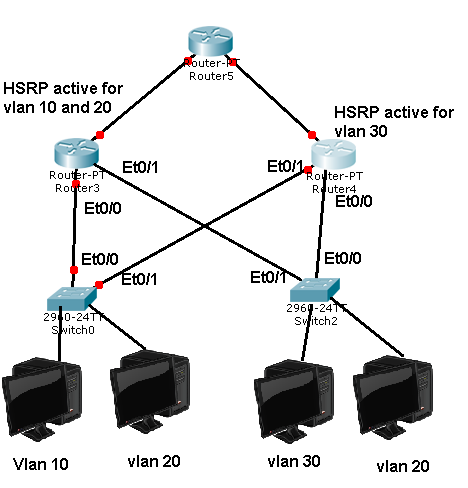- Cisco Community
- Technology and Support
- Networking
- Switching
- HSRP links configuration
- Subscribe to RSS Feed
- Mark Topic as New
- Mark Topic as Read
- Float this Topic for Current User
- Bookmark
- Subscribe
- Mute
- Printer Friendly Page
- Mark as New
- Bookmark
- Subscribe
- Mute
- Subscribe to RSS Feed
- Permalink
- Report Inappropriate Content
03-14-2016 10:41 AM - edited 03-08-2019 04:57 AM
Hi,
I really have a hard time figuring out this configuration, and I know it's a really basic config,
I wanted the full config of [interfaces 0/0 and 0/1 on switches 0 and 2] and [interfaces 0/0 and 0/1 on routers 3 and 4] for hsrp and intervlan support.
Vlans 10,20 will be Active on router 3 and Vlans 30 will be Active on router 4.(and suppose we do not have l3 switches.)
three other questions
1. what are the types of eth0/0 and eth0/1 interfaces on those switches, are they trunk or access ports?
2. can routers have L3 SVIs just like L3 switches have? which can be used as a default gateway for vlans to switch over to eachother?
3. can you connect a switch trunk port to a physical router L3 port, what that means?(in one side(router) which only understands l3 packets, and in other side(switch) you send .1q packets?please explain...)
because I thought before this we only have router on stick(sub interfaces for each vlan or physical interfaces for each vlan) solution for interconnection of a switch trunk and router l3 port.

thx
Solved! Go to Solution.
- Labels:
-
Other Switching
Accepted Solutions
- Mark as New
- Bookmark
- Subscribe
- Mute
- Subscribe to RSS Feed
- Permalink
- Report Inappropriate Content
03-14-2016 11:03 AM
You can't use that setup for what you want because a router cannot have multiple interfaces or subinterfaces in the same IP subnet and with your setup that is what would be needed.
So what you do instead is to have a trunk link connecting your two switches together which allows those vlans.
Then a connection from switch 0 to router 3 which is trunk link allowing those vlans and a connection from switch 2 to router 4, again a trunk link allowing those vlans.
On the router you configure subinterfaces, one per vlan and then configure HSRP.
HSRP traffic will flow between the routers via the switches which is why you need an interconnect between your switches.
To answer your specific questions -
1) the interfaces on the switches need to be trunk ports
2) they can if they have switch modules installed but if not then you need to use subinterfaces on the router
3) yes you can and you use subinterfaces on the router together with the "encapsulation dot1q <vlan ID>" command to tell the router to accept tagged packets for that vlan on the subinterface.
Jon
- Mark as New
- Bookmark
- Subscribe
- Mute
- Subscribe to RSS Feed
- Permalink
- Report Inappropriate Content
03-14-2016 11:03 AM
You can't use that setup for what you want because a router cannot have multiple interfaces or subinterfaces in the same IP subnet and with your setup that is what would be needed.
So what you do instead is to have a trunk link connecting your two switches together which allows those vlans.
Then a connection from switch 0 to router 3 which is trunk link allowing those vlans and a connection from switch 2 to router 4, again a trunk link allowing those vlans.
On the router you configure subinterfaces, one per vlan and then configure HSRP.
HSRP traffic will flow between the routers via the switches which is why you need an interconnect between your switches.
To answer your specific questions -
1) the interfaces on the switches need to be trunk ports
2) they can if they have switch modules installed but if not then you need to use subinterfaces on the router
3) yes you can and you use subinterfaces on the router together with the "encapsulation dot1q <vlan ID>" command to tell the router to accept tagged packets for that vlan on the subinterface.
Jon
Discover and save your favorite ideas. Come back to expert answers, step-by-step guides, recent topics, and more.
New here? Get started with these tips. How to use Community New member guide